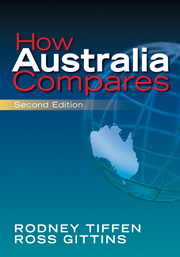Book contents
- Frontmatter
- Contents
- List of tables and figures
- Preface to the second edition
- Acknowledgements
- Reading the tables
- Abbreviations
- Introduction
- 1 People
- 2 Government and politics
- 3 Economics
- 4 Work and labour
- 5 Government taxes and spending
- 6 Health
- 7 Education
- 8 Inequality and social welfare
- 9 International relations
- 10 Environment
- 11 Science and technology
- 12 Telecommunications and computing
- 13 Media
- 14 Family
- 15 Lifestyles and consumption
- 16 Crime and social problems
- 17 The search for scoreboards
- 18 The Howard impact
- Sources and references
Introduction
Published online by Cambridge University Press: 05 June 2012
- Frontmatter
- Contents
- List of tables and figures
- Preface to the second edition
- Acknowledgements
- Reading the tables
- Abbreviations
- Introduction
- 1 People
- 2 Government and politics
- 3 Economics
- 4 Work and labour
- 5 Government taxes and spending
- 6 Health
- 7 Education
- 8 Inequality and social welfare
- 9 International relations
- 10 Environment
- 11 Science and technology
- 12 Telecommunications and computing
- 13 Media
- 14 Family
- 15 Lifestyles and consumption
- 16 Crime and social problems
- 17 The search for scoreboards
- 18 The Howard impact
- Sources and references
Summary
‘Australia is the best country in the world.’ When people feel strongly about something, they often express themselves by making a comparative claim, but usually without taking the comparison seriously. Every country seems to invent myths about its own uniqueness (‘Australia is the most egalitarian country in the world’), myths typically based on an ignorance of others. Mostly such casual comparisons flatter the country they are describing. More occasionally they indulge in self-flagellation (‘Australia is the most over-governed country in the world, with the world's worst politicians’) or express a cultural cringe (‘We are always 10 years behind America’).
This book makes comparison its central purpose. It systematically compares Australia with 17 other countries, all affluent and stable liberal democracies, on a wide range of important social, economic and political phenomena.
Moreover, it seeks, whenever possible, not just to make snapshot comparisons from the present, but to chart trends. While there is value in presenting comparisons frozen at a single point of time, it is more instructive to trace common or contrasting trajectories – whether all these countries are experiencing greater unemployment, increased health spending, rising crime rates etc. There is an industry of politicians, journalists and market analysts devoted to intensively reporting short-term changes, and sometimes exaggerating their significance. There is much less public effort devoted to analysing the medium term and long term.
- Type
- Chapter
- Information
- How Australia Compares , pp. 1 - 3Publisher: Cambridge University PressPrint publication year: 2009



